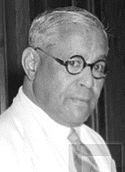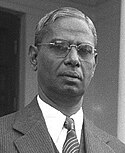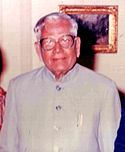Ministerstwo Finansów Indii
| IndieTen artykuł jest częścią serii: Ustrój i polityka Indii Ustrój polityczny Konstytucja Władza ustawodawcza Władza wykonawcza Władza sądownicza Kontrola państwowa Finanse Samorząd terytorialny Partie polityczne Wybory Polityka zagraniczna Wikiprojekt Polityka |
Ministerstwo Finansów Indii − ministerstwo odpowiadające za prowadzenie polityki finansowej Indii.
Mieści się w kompleksie rządowym w Raisina Hill w Nowym Delhi.
Obecnym ministrem spraw zagranicznych jest Arun Jaitley.
Lista ministrów finansów Indii
Poniższa tabela zawiera listę wszystkich ministrów finansów Indii, od uzyskania przez ten kraj niepodległości w 1947[1].
| Imię i nazwisko | Zdjęcie | Od | Do | Partia | Uwagi |
|---|---|---|---|---|---|
| R.K. Shanmukham Chetty |  | 15 sierpnia 1947 | 22 września 1948 | INC | |
| John Matthai |  | 22 września 1948 | 26 maja 1950 | INC | |
| Chintaman Deshmukh | 26 maja 1950 | 24 lipca 1956 | INC | ||
| Jawaharlal Nehru |  | 24 lipca 1956 | 30 sierpnia 1956 | INC | pierwszy raz, jednocześnie premier |
| T.T. Krishnamachari | 30 sierpnia 1956 | 13 lutego 1958 | INC | pierwszy raz | |
| Jawaharlal Nehru |  | 13 lutego 1958 | 13 marca 1958 | INC | drugi raz, jednocześnie premier |
| Morarji Desai[2] |  | 13 marca 1958 | 29 sierpnia 1963 | INC | pierwszy raz |
| T.T. Krishnamachari | 29 sierpnia 1963 | 31 grudnia 1965 | INC | drugi raz | |
| Sachindra Chaudhuri | 31 grudnia 1965 | 13 marca 1967 | INC | ||
| Morarji Desai | 13 marca 1967 | 16 lipca 1969 | INC | drugi raz | |
| Indira Gandhi[3] |  | 16 lipca 1969 | 27 czerwca 1970 | INC | jednocześnie premier |
| Yashwantrao Chavan[4] | 27 czerwca 1970 | 10 października 1974 | INC | ||
| Chidambaram Subramaniam[5] | 10 października 1974 | 27 marca 1977 | INC | ||
| H.M. Patel | 27 marca 1977 | 24 stycznia 1979 | Janata | ||
| Charan Singh | 24 stycznia 1979 | 28 lipca 1979 | Janata | ||
| Hemwati Nandan Bahuguna | 28 lipca 1979 | 14 stycznia 1980 | Janata Party (Secular) | ||
| Ramaswamy Venkataraman |  | 14 stycznia 1980 | 15 stycznia 1982 | INC | |
| Pranab Mukherjee |  | 15 stycznia 1982 | 31 grudnia 1984 | INC | pierwszy raz |
| Vishwanath Pratap Singh |  | 31 grudnia 1984 | 24 stycznia 1987 | INC | |
| Rajiv Gandhi[6] |  | 24 stycznia 1987 | 25 lipca 1987 | INC | |
| Narain Dutt Tiwari | 25 lipca 1987 | 25 czerwca 1988 | INC | ||
| Shankarrao Chavan[7] | 25 czerwca 1988 | 5 grudnia 1989 | INC | ||
| Madhu Dandavate | 5 grudnia 1989 | 21 listopada 1990 | Janata Dal | ||
| Yashwant Sinha |  | 21 listopada 1990 | 21 czerwca 1991 | Samajwadi Janata Party | pierwszy raz |
| Manmohan Singh[8] |  | 21 czerwca 1991 | 16 maja 1996 | INC | pierwszy raz |
| Jaswant Singh |  | 16 maja 1996 | 1 czerwca 1996 | Indyjska Partia Ludowa | pierwszy raz |
| Palaniappan Chidambaram |  | 1 czerwca 1996 | 21 kwietnia 1997 | Tamil Maanila Congress | pierwszy raz |
| Inder Kumar Gujral[9] |  | 21 kwietnia 1997 | 1 maja 1997 | Janata Dal | |
| Palaniappan Chidambaram |  | 1 maja 1997 | 19 marca 1998 | Tamil Maanila Congress | drugi raz |
| Yashwant Sinha | 19 marca 1998 | 1 lipca 2002 | Indyjska Partia Ludowa | drugi raz | |
| Jaswant Singh |  | 1 lipca 2002 | 22 maja 2004 | Indyjska Partia Ludowa | drugi raz |
| Palaniappan Chidambaram |  | 23 maja 2004 | 30 listopada 2008 | INC | trzeci raz |
| Manmohan Singh |  | 30 listopada 2008 | 23 maja 2009 | INC | drugi raz |
| Pranab Mukherjee |  | 24 stycznia 2009 | 26 czerwca 2012 | INC | drugi raz |
| Manmohan Singh |  | 26 czerwca 2012 | 31 lipca 2012 | INC | trzeci raz |
| Palaniappan Chidambaram |  | 31 lipca 2012 | 26 maja 2014 | INC | czwarty raz |
| Arun Jaitley |  | 27 maja 2014 | Indyjska Partia Ludowa |
Przypisy
- ↑ rulers.org: India. Ministries, etc.
- ↑ Morarji Desai w rulers.org
- ↑ Indira Gandhi w rulers.org
- ↑ Yashwantrao Chavan w rulers.org
- ↑ Chidambaram Subramaniam w rulers.org
- ↑ Rajiv Gandhi w rulers.org
- ↑ Shankarrao Chavan w rulers.org
- ↑ Manmohan Singh w rulers.org
- ↑ Inder Kumar Gujral w rulers.org
Bibliografia
Linki zewnętrzne
Media użyte na tej stronie
Autor: World Economic Forum, Licencja: CC BY-SA 2.0
Prime Minister Manmohan Singh in the Opening Plenary - Resillient india: 25 years of Economic and Social Progress. Participants captured during the World Economic Forum's India Economic Summit 2009 held in New Delhi, 8-10 November 2009.
Autor: Edmund Gall, Licencja: CC BY-SA 2.0
North Block, Central Secretariat.
The National Emblem of India is derived from the time of the Emperor Ashoka. The emblem is a replica of the Lion of Sarnath, near Varanasi in Uttar Pradesh. The Lion Capital was erected in the third century BC by Emperor Ashoka to mark the spot where Buddha first proclaimed his gospel of peace and emancipation to the four quarters of the universe. The national emblem is thus symbolic of contemporary India’s reaffirmation of its ancient commitment to world peace and goodwill. The four lions(one hidden from view ) – symbolising power, courage and confidence- rest on a circular abacus. The abacus is girded by four smaller animals—Guardians of the four directions: The Lion of the North, The Horse of the West, The Bull of the South and The Elephant of the East. The abacus rests on a lotus in full bloom, exemplifying the fountainhead of life and creative inspiration. The motto 'Satyameva Jayate' inscribed below the emblem in Devanagari script means 'truth alone triumphs'.
John Mathai on 3 August 1949.
Autor: Copyright World Economic Forum (www.weforum.org)/Photo by Norbert Schiller, Licencja: CC BY-SA 2.0
India's Minister of Finance Palaniappan Chidambaram is the special guest at a plenary session titled Risks to India's Economy in a Post-Crisis World held at the World Economic Forum's India Economic Summit 2008 in New Delhi, 16-18 November 2008.
(c) Bundesarchiv, Bild 183-61849-0001 / CC-BY-SA
Dla celów dokumentacyjnych Niemieckie Archiwum Federalne często zachowywało oryginalny opis fotografii, który może być błędny, tendencyjny, przestarzały bądź politycznie skrajny. Korekty i alternatywne opisy są wpisane oddzielnie od opisu oryginalnego. Dodatkowe błędy można zgłaszać na tej stronie w celu poinformowania Niemieckiego Archiwum Federalnego.
Oryginalny opis Archiwum:
Indien, Otto Grotewohl bei Ministerpräsident Nehru Zentralbild/Heilig 27.1.59 Ministerpräsident Grotewohl bei Ministerpräs bcggffd grdetsfgsdeident Nehru Ministerpräsident Otto Grotewohl und der indische Ministerpräsident Nehru trafen am 12.1.59 zu einer Unterredung zusammen. Das Gespräch währte drei Stunden und verlief sehr herzlich. UBz.: Ministerpräsident Nehru (links) im freundschaftlichen Gespräch mit Ministerpräsident Otto Grotewohl (links im Hintergrund) der Stellvertreter des Vorsitzenden des Ministerrates und Minister für Auswärtige Angelegenheiten, Dr. Lothar Bohlz. Abgebildete Personen: * Grotewohl, Otto: Ministerpräsident, stellvertretender Staatsratsvorsitzender, DDR * Nehru, Jawaharlal Pandit: Premierminister, Präsident der Kongresspartei, Indien
Autor:
- Rajiv Gandhi meeting Russian Hare Krishna devotees in New Delhi 1989.jpg: ISKCON Russia
- derivative work: Indopug
Rajiv Gandhi in New Delhi, 1989.
Autor: World Economic Forum, Licencja: CC BY-SA 2.0
Minister of Finance Pranab Mukherjee in the Plenary Session Post-Crisis Economic Order: How Can Free Market and control be Balanced? Participants captured during the World Economic Forum's India Economic Summit 2009 held in New Delhi, 8-10 November 2009.
Autor: Biswarup Ganguly, Licencja: CC BY-SA 3.0
Inder Kumar Gujral (born 4 December 1919) served as the 13th Prime Minister of the Republic of India. This photograph was taken at Science City, Kolkata on traditional 35 mm film; the negative was scanned by Nikon scanner after 10 years. It is a cropped image.
Yashwant Sinha, Former Union Minister of External Affairs
ജസ്വന്ത് സിംഹ്


















